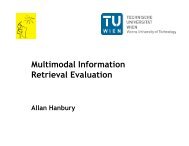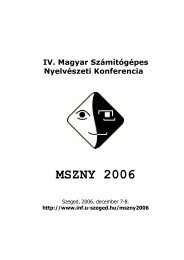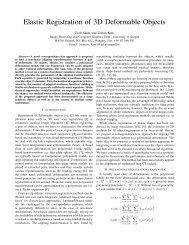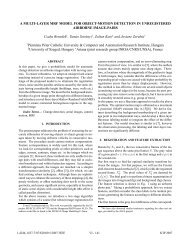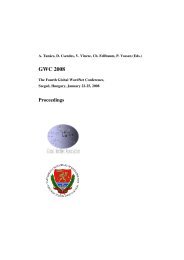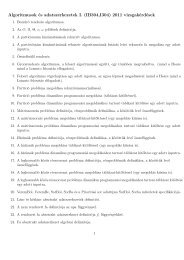Shape Moments for Region- Based Active Contours
Shape Moments for Region- Based Active Contours
Shape Moments for Region- Based Active Contours
Create successful ePaper yourself
Turn your PDF publications into a flip-book with our unique Google optimized e-Paper software.
<strong>Shape</strong> <strong>Moments</strong> <strong>for</strong> <strong>Region</strong>-<br />
<strong>Based</strong> <strong>Active</strong> <strong>Contours</strong><br />
Peter Horvath, Avik Bhattacharya,<br />
Ian Jermyn, Josiane Zerubia and<br />
Zoltan Kato<br />
SSIP 2005
Goal<br />
o Introduce shape prior into the<br />
Chan and Vese model<br />
Improve per<strong>for</strong>mance in<br />
the presence of:<br />
•Occlusion<br />
•Cluttered background<br />
•Noise<br />
SSIP 2005
Overview<br />
o <strong>Region</strong>-based active contours<br />
o The Mum<strong>for</strong>d-Shah model<br />
o The Chan and Vese model<br />
o Level-set function<br />
o <strong>Shape</strong> moments<br />
o Geometric moments<br />
o Legendre moments<br />
o Chebyshev moments<br />
o Segmentation with shape prior<br />
o Experimental results<br />
SSIP 2005
Mum<strong>for</strong>d-Shah model<br />
oD. Mum<strong>for</strong>d, J. Shah in 1989<br />
oGeneral segmentation model<br />
o••R 2 , u 0 -given image, u-segmented<br />
image, C-contour<br />
E<br />
MS<br />
2<br />
2<br />
( u,<br />
C)<br />
= λ ( u − u)<br />
dx + ∇u<br />
dx + µ<br />
∫<br />
Ω<br />
0<br />
∫<br />
Ω\<br />
C<br />
1 2 3<br />
1. <strong>Region</strong> similarity<br />
2. Smoothness<br />
3. Minimizes the contour length<br />
2<br />
| C<br />
|<br />
SSIP 2005
Chan and Vese model I.<br />
o Intensity based segmentation<br />
o Piecewise constant Mum<strong>for</strong>d-Shah<br />
energy functional (cartoon model)<br />
o Inside (c 1 ) and outside (c 2 ) regions<br />
2<br />
2<br />
ECV ( c1 , c2,<br />
C)<br />
λ1<br />
( u0<br />
− c1<br />
) dx + λ2<br />
( u0<br />
− c2)<br />
dx +<br />
= ∫ ∫<br />
Ω<br />
in<br />
o <strong>Active</strong> contours without edges [Chan<br />
and Vese, 1999]<br />
o Level set <strong>for</strong>mulation of the above model<br />
o Energy minimization by gradient descent<br />
Ω<br />
out<br />
C<br />
SSIP 2005
Level-set method<br />
o S. Osher and J. Sethian in 1988<br />
o Embed the contour into a higher<br />
dimensional space<br />
o Automatically handles the topological<br />
changes<br />
o φ(., t) level set function<br />
o Implicit contour (φ = 0)<br />
o Contour is evolved<br />
implicitly by moving<br />
the surface φ<br />
SSIP 2005
Chan and Vese model II.<br />
o Level set segmentation model<br />
o Inside φ>0; outside φ
Overview<br />
o <strong>Region</strong>-based active contours<br />
o The Mum<strong>for</strong>d-Shah model<br />
o The Chan and Vese model<br />
o Level-set function<br />
o <strong>Shape</strong> moments<br />
o Geometric moments<br />
o Legendre moments<br />
o Chebyshev moments<br />
o Segmentation with shape prior<br />
o Experimental results<br />
SSIP 2005
Geometric shape moments<br />
o Introduced by M. K. Hu in 1962<br />
o Normalized central moments (NCM)<br />
η<br />
o Translation and scale invariant<br />
o (x c , y c ) is the centre of mass (translation<br />
invariance)<br />
x x<br />
p<br />
y y<br />
q<br />
c<br />
c<br />
pq = ( − ) ( − )<br />
∫∫<br />
M<br />
( p+<br />
q+<br />
2) 2<br />
00<br />
Area of the object<br />
(scale invariance)<br />
dxdy<br />
SSIP 2005
Legendre moments<br />
λ pq<br />
=<br />
(2 p<br />
+ 1)(2q<br />
4<br />
+ 1)<br />
1<br />
1<br />
∫ ∫<br />
−1<br />
−1<br />
P<br />
( x)<br />
P<br />
( y)<br />
f ( x,<br />
y)<br />
dxdy<br />
o Provides a more detailed representation than<br />
normalized central moments:<br />
<strong>Shape</strong><br />
p<br />
•Where P p (x) are the<br />
Legendre polynomials<br />
•Orthogonal basis functions<br />
NCM (h) Legendre (l)<br />
q<br />
NCM is dominated<br />
by few moments<br />
while Legendere<br />
values are evenly<br />
distributed<br />
SSIP 2005
Chebyshev moments<br />
o Ideal choice because discrete<br />
T<br />
mn<br />
=<br />
N − 1 N −1<br />
1<br />
ρ(<br />
m,<br />
N)<br />
ρ(<br />
n,<br />
M )<br />
∑∑<br />
i=<br />
0<br />
j=<br />
0<br />
( i)<br />
T<br />
o Where, ƒ(n, N) is the normalizing term,<br />
T m (.) is the Chebyshev polynomial<br />
o Can be expressed in term of<br />
geometric moments<br />
Chebyshev<br />
polynomials:<br />
T<br />
m<br />
n<br />
( j)<br />
f<br />
( i,<br />
j)<br />
SSIP 2005
Overview<br />
o <strong>Region</strong>-based active contours<br />
o The Mum<strong>for</strong>d-Shah model<br />
o The Chan and Vese model<br />
o Level-set function<br />
o <strong>Shape</strong> moments<br />
o Geometric moments<br />
o Legendre moments<br />
o Chebyshev moments<br />
o Segmentation with shape prior<br />
o Experimental results<br />
SSIP 2005
New energy function<br />
o We define our energy functional:<br />
E ( c1,<br />
c2,<br />
φ,<br />
π<br />
ref<br />
) = ECV<br />
( c1,<br />
c2,<br />
φ)<br />
+ E<br />
prior<br />
( π<br />
ref<br />
, φ)<br />
o Where E prior defined as the distance<br />
between the shape and the reference<br />
moments<br />
E prior<br />
p,<br />
q ≤ N<br />
∑<br />
pq<br />
( π , φ)<br />
= ( π −π<br />
ref<br />
p,<br />
q<br />
pq<br />
ref<br />
2<br />
)<br />
o π pq shape moments<br />
SSIP 2005
Overview<br />
o <strong>Region</strong>-based active contours<br />
o The Mum<strong>for</strong>d-Shah model<br />
o The Chan and Vese model<br />
o Level-set function<br />
o <strong>Shape</strong> moments<br />
o Geometric moments<br />
o Legendre moments<br />
o Chebyshev moments<br />
o Segmentation with shape prior<br />
o Experimental results<br />
SSIP 2005
Geometric results<br />
Legendre moments<br />
Reference<br />
object<br />
p, q •12 p, q •16 p, q •20<br />
Chebyshev moments<br />
p, q •12 p, q •16 p, q •20<br />
SSIP 2005
Result on real image<br />
Original<br />
image<br />
Reference<br />
object<br />
Chan and Vese<br />
Chan and Vese<br />
with shape prior<br />
SSIP 2005
Conclusions, future work<br />
o Legendre is faster<br />
o Chebyshev is slower but it’s<br />
discrete nature gives better<br />
representation<br />
o Future work:<br />
o Extend our model to Zernike<br />
moments<br />
o Develop segmentation methods<br />
using shape moments and Markov<br />
Random Fields<br />
SSIP 2005
Thank you!<br />
Acknowledgement:<br />
•IMAVIS EU project (IHP-MCHT99/5)<br />
•Balaton program<br />
•OTKA (T046805)<br />
SSIP 2005






